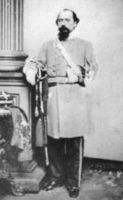 | Back to e-WV
| Back to e-WV
 The West Virginia Encyclopedia
The West Virginia Encyclopedia
 | Back to e-WV
| Back to e-WV
 The West Virginia Encyclopedia
The West Virginia Encyclopedia

Within a few months after the beginning of the Civil War, federal forces had occupied the strategic Kanawha Valley from Gauley Bridge at the headwaters of the Great Kanawha River to Point Pleasant where the Kanawha flowed into the Ohio. So it remained until September 1862, when events in Maryland set in motion the circumstances that led to Gen. William W. Loring’s raid on Kanawha Valley. Robert E. Lee, seeking to bring the war to a decisive end, took his army into Maryland, where he eventually would meet the enemy at Antietam. As the Union army under Gen. George McClellan maneuvered to stop Lee, about 5,000 federal occupation troops in the Kanawha Valley, half of the force, were called away. That seriously weakened the Union position.
Richmond learned of the federal move and ordered General Loring to begin an attack on the Kanawha Valley from the Confederate stronghold around Pearisburg, Virginia. Loring’s command consisted of nine regiments of infantry and artillery batteries. Serious fighting began on September 10 at Fayetteville, resulting in a federal retreat by Gen. Joseph Lightburn that did not end until his troops fled across the Ohio river at Ravenswood.
On September 13 an attempt was made by the Union forces to halt the rout at Charleston, but Southern artillery gained the heights on Fort Hill and smashed the federals who were lining the west bank of the Elk River after cutting the suspension bridge at what is now Washington Street. The Confederate victory, joyously received by many Charlestonians with sons fighting in the Southern army, was short lived. After about a month, the return of the Union soldiers from Maryland made the Confederate position untenable. The boys in gray left the valley never to return as soldiers but instead as defeated men to a new state called West Virginia.
Written by Richard A. Andre